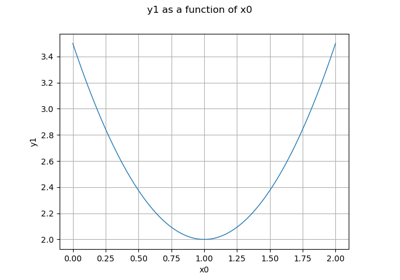Tensor¶
- class Tensor(*args)¶
Tensor.
- Available constructors:
Tensor(n_rows, n_columns, n_sheets)
Tensor(n_rows, n_columns, n_sheets, values)
Tensor(sequence)
- Parameters:
- n_rowsint,
Number of rows.
- n_columnsint,
Number of columns.
- n_sheetsint,
Number of sheets.
- valuessequence of float with size
, optional
Values. OpenTURNS uses column-major ordering (like Fortran) for reshaping the flat list of values. If not mentioned, a zero tensor is created.
- sequencesequence of float
Values.
- n_rowsint,
Methods
clean(threshold)Set elements smaller than a threshold to zero.
Accessor to the object's name.
getId()Accessor to the object's id.
Accessor to the underlying implementation.
getName()Accessor to the object's name.
Accessor to the number of columns.
Accessor to the number of rows.
Accessor to the number of sheets.
getSheet(k)Get a sheet of the tensor.
isEmpty()Tell if the tensor is empty.
setName(name)Accessor to the object's name.
setSheet(k, m)Set a matrix as a sheet of the complex tensor.
Examples
>>> import openturns as ot >>> print(ot.Tensor(2, 2, 2, [1])) sheet #0 [[ 1 0 ] [ 0 0 ]] sheet #1 [[ 0 0 ] [ 0 0 ]] >>> T = ot.Tensor(2, 2, 3, range(2*2*3)) >>> print(T) sheet #0 [[ 0 2 ] [ 1 3 ]] sheet #1 [[ 4 6 ] [ 5 7 ]] sheet #2 [[ 8 10 ] [ 9 11 ]]
Get or set terms:
>>> print(T[0, 0, 0]) 0.0 >>> T[0, 0, 0] = 1. >>> print(T[0, 0, 0]) 1.0
Create an openturns tensor from a sequence:
>>> T = ot.Tensor([[[1.0, 2.0, 3.0], [4.0, 5.0, 6.0]], [[7.0, 8.0, 9.0], [10.0, 11.0, 12.0]]]) >>> print(T) sheet #0 [[ 1 4 ] [ 7 10 ]] sheet #1 [[ 2 5 ] [ 8 11 ]] sheet #2 [[ 3 6 ] [ 9 12 ]]
- __init__(*args)¶
- clean(threshold)¶
Set elements smaller than a threshold to zero.
- Parameters:
- thresholdfloat
Threshold for zeroing elements.
- Returns:
- cleaned_tensor
Tensor Input tensor with elements smaller than the threshold set to zero.
- cleaned_tensor
- getClassName()¶
Accessor to the object’s name.
- Returns:
- class_namestr
The object class name (object.__class__.__name__).
- getId()¶
Accessor to the object’s id.
- Returns:
- idint
Internal unique identifier.
- getImplementation()¶
Accessor to the underlying implementation.
- Returns:
- implImplementation
A copy of the underlying implementation object.
- getName()¶
Accessor to the object’s name.
- Returns:
- namestr
The name of the object.
- getNbColumns()¶
Accessor to the number of columns.
- Returns:
- n_columnsint
- getNbRows()¶
Accessor to the number of rows.
- Returns:
- n_rowsint
- getNbSheets()¶
Accessor to the number of sheets.
- Returns:
- n_sheetsint
Examples
>>> import openturns as ot >>> T = ot.Tensor(2, 2, 3, range(2*2*3)) >>> print(T.getNbSheets()) 3
- getSheet(k)¶
Get a sheet of the tensor.
- Parameters:
- sheetint
Index of sheet element.
- Returns:
- M
Matrix The sheet element.
- M
Examples
>>> import openturns as ot >>> T = ot.Tensor(2, 2, 3, range(2*2*3)) >>> print(T.getSheet(1)) [[ 4 6 ] [ 5 7 ]]
- isEmpty()¶
Tell if the tensor is empty.
- Returns:
- is_emptybool
True if the tensor contains no element.
Examples
>>> import openturns as ot >>> T = ot.Tensor() >>> T.isEmpty() True
- setName(name)¶
Accessor to the object’s name.
- Parameters:
- namestr
The name of the object.
- setSheet(k, m)¶
Set a matrix as a sheet of the complex tensor.
- Parameters:
- sheetint
Index of sheet element.
- M
Matrix The matrix.
Examples
>>> import openturns as ot >>> T = ot.Tensor(2, 2, 3, range(2*2*3)) >>> print(T) sheet #0 [[ 0 2 ] [ 1 3 ]] sheet #1 [[ 4 6 ] [ 5 7 ]] sheet #2 [[ 8 10 ] [ 9 11 ]] >>> M = ot.Matrix([[1, 2],[3, 4]]) >>> T.setSheet(0, M) >>> print(T) sheet #0 [[ 1 2 ] [ 3 4 ]] sheet #1 [[ 4 6 ] [ 5 7 ]] sheet #2 [[ 8 10 ] [ 9 11 ]]
 OpenTURNS
OpenTURNS
